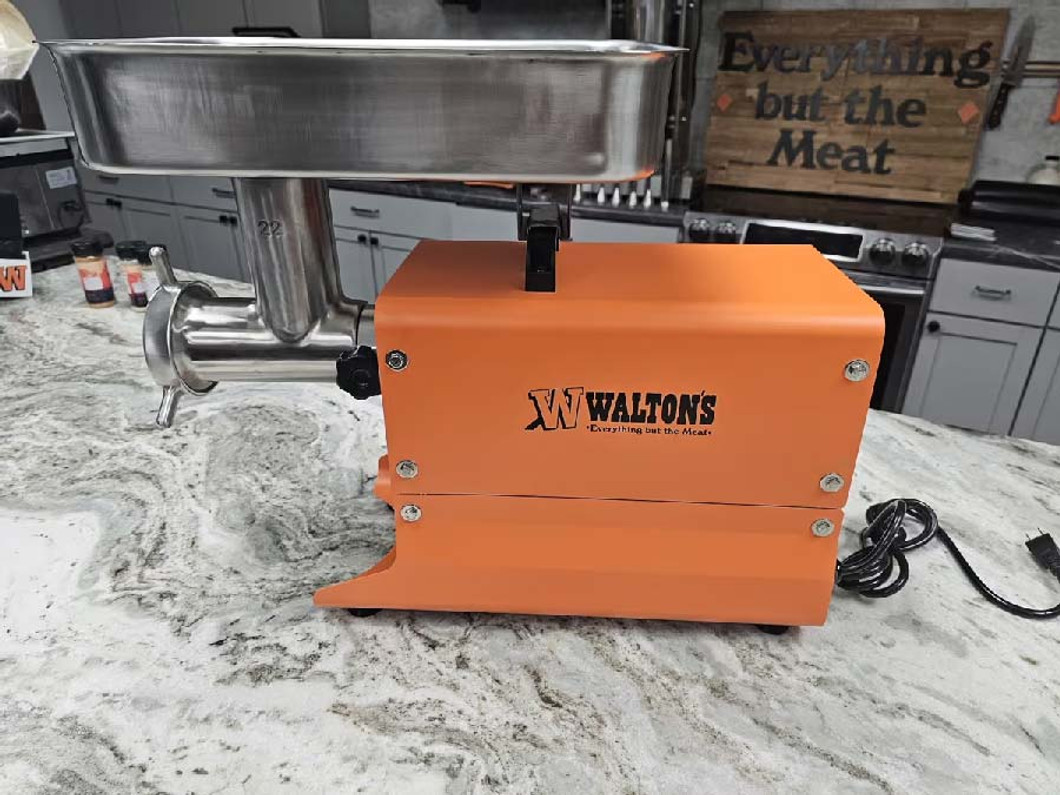Introduction to Sausage Making
Are you ready to start your journey into the world of at-home meat processing but need help figuring out where to begin? If you're a beginner, like we all were at some point, then you've come to the right place! In Walton's beginner's guide to at-home meat processing, we'll go over all the essentials you will need to get started. Let's get started!
Walton's Meat Grinder
The meat grinder's primary function is breaking down whole muscle cuts of meat into a ground format that can be seasoned, cured, stuffed into a casing, and cooked. Unless you want to purchase ground meat, you will want a meat grinder in your home processing arsenal.
Electric grinders have a hopper at the top where you load the meat. The hopper leads down to the throat of the grinder, where an auger powered by the motor pushes the meat towards the plate and knife that will cut and grind your meat. The grinding knife goes behind the plate with the sharpened surface facing toward the plate; this cuts the meat and forces it through the holes of the grinding plate. The larger the holes on the grinding plate, the faster your meat will grind and the coarser your product will be. Many products need to be ground twice, sometimes through a larger plate first, then through a smaller plate, and sometimes twice through a larger plate.
The Walton's #12 meat grinder is an excellent choice for beginners. This unit packs plenty of power to break down more significant cuts of meat with a medium-sized plate while remaining friendly to your budget.
Walton's Sausage Stuffer
Sausage stuffers are ideal for getting ground meat into a casing or bag. A stuffer is an essential piece of equipment for any home processor. Sausage stuffers make it easy to get near perfectly filled casings almost always. They also allow you to use much smaller casings than you would be able to if you were trying to stuff off of a grinder attachment.
Walton's manual sausage stuffers have two gears: one on the bottom designed for stuffing and one above, which is only used to quickly reverse your piston out of the canister, allowing you to quickly load more meat. The canister is secured to the frame by two brackets on each side. Your ground and seasoned meat is loaded into the canister by tilting the canister backward; once it has been filled, it needs to be locked back in place. Attach the hand crank to the lower gear on the side and begin cranking. As you crank, the gears will turn in the gearbox, forcing the rack down and pushing the piston down through the canister. This will force your meat down and out of the stuffing tube at the bottom and into your casing or meat bag.
A sausage stuffer is a great first purchase for a home processor because it allows you to work with pre-ground meat. Both the 7-lb and 11-lb Walton's sausage stuffers are great options for beginners who will start off doing small batches. These models have a smaller diameter piston, requiring less force to crank down the handle.
Walton's Meat Mixer
The job of the meat mixer is to mix seasoning, cure, and other additives evenly within the meat to achieve the best, most consistent flavor. It also plays a vital role in protein extraction when making cured sausage products.
You can mix seasoning, cures, and additives by hand or add them between the first and second grind on your products and let your meat grinder do some of the work for you. These methods are more appropriate with uncured products, but they can also work for cured products; it will be more time-consuming, and you might end up with an inferior product.
If you are making cured products, the meat mixer is a must-have piece of equipment. Lack of proper protein extraction can lead to a host of problems while cooking and smoking products. If you are making only fresh products, it is optional as the proper level of mixing can be achieved by hand, but it can be convenient to have, saving you a lot of time and effort, especially if you are working with larger batches.
The Walton's 20 lb meat mixer is a nice size for making smaller batches, the scoop and drop action helps with protein extraction, and it is relatively easy to break down and clean, all for $169.
Seasoning
No matter what type of meat processing project you want, you will need seasoning. Whether you're making fresh or cured sausage, homemade jerky, or snack sticks, the proper seasoning brings it all home with the flavor you're looking for.
Walton's has seasonings to match any taste. Whether you're looking for savory and bold, something sweeter, or even some heat, we have options for whatever you're craving. Be bold and stock up with all those flavors that tickle your fancy! Most seasonings come with a 2-year best if used by date. This does not mean that any remaining seasoning must be thrown out on that date, but it does mean that it has reached the end of its peak efficiency and should either be used shortly or discarded. It's also best practice to vacuum seal unused seasonings to maintain freshness.
Casings
When making sausage you will almost certainly use either a natural hog casing, or a collagen casing. Both have their advantages and disadvantages.
Natural casings are generally made from hog or sheep intestines that have been cleaned and processed to make them edible. They are kept fresh by being packed in salt or in a salt solution, so you will have to rinse and soak them before stuffing. Natural casings are smoke-permeable, accept a twist, and can easily be hung in a smokehouse. However, they are thinner and more prone to blowouts, so you must be careful not to overstuff these casings.
Collagen casings come in both a few varieties. Edible collagen casings come in three types: fresh, clear, and smoked. Fresh collagen casings are only used for products like bratwurst or breakfast sausage because they cannot be hung in a smoker. Clear casings are strong enough to hang in a smoker and provide a clear appearance after cooking. Finally, we have smoked collagen casings, which are strong enough to be hung in a smokehouse and have a reddish mahogany appearance. Edible collagen casings do not have to be soaked or processed like natural casings. They will go directly to your stuffer once you open the package.
Additives
Additives are essential for any smoked meat product. Fresh sausages like bratwurst only need to be seasoned, but anything like summer sausage or snack sticks will require some additives. The most important additives are a curing agent like Sure Cure, a meat binder like Sure Gel, and a cure accelerator like sodium erythorbate.
Sure Cure is a mix of salt and nitrites used to cure meat for products like snack sticks and summer sausage before they are smoked, ensuring it is safe for consumption. Its primary purpose is to stop the growth of botulism spores, one of the leading causes of food poisoning. Products like snack sticks and summer sausage are cooked in a moist, hot environment, but not hot enough to kill these spores. Sure Cure also preserves the smoke and spice flavor in a cured product.
Meat binders like Sure Gel or soy protein blend contain some protein, making protein extraction more efficient as more of it becomes available. The Soy Protein blend has a grain or cereal-like appearance and will look like oats if you soak it in water, but it will dissolve into your product, so it will not leave any noticeably different consistency. Both of these have allergens, though, so you must be somewhat careful. Carrot Fiber is a binder that can hold 26 times its weight in water. It is allergen-free, inexpensive, and imparts very little if any, taste to your cooked product. Any of these products will improve the texture of your finished product.
Cure accelerators interact with the cure to speed up its conversion from Nitrite to nitric oxide gas and allow you to go directly from stuffing to the smokehouse. When used, you do not need to hold your product overnight to allow the cure time to work. Cure Accelerator from Excalibur and sodium erythorbate are cure accelerators with minimal if any, effect on taste. Encapsulated Citric Acid acts as both a cure accelerator and a pH reducer, giving meat snacks that nice tang.
Meat Block
Sausage can be made from nearly any meat. Pork is the most common as it is readily available and relatively inexpensive; beef is also reasonably common, and chicken sausage is becoming more common and commercially available. Regardless of the meat block used, we recommend between a 80/20 and a 70/30 meat-to-fat ratio. If you need to add extra fat, we always recommend pork fat because it grinds effortlessly into a creamy consistency with a bright white color and does not change the flavor of what you're making.
If a leaner wild game such as venison is used, the correct amount of pork fat must be added, or the finished product will be less flavorful and dry. The best time to add this pork fat is during the second grind so it can mix in well with the lean meat.
Recipes
To help get you started on your home meat processing journey, here are a few recipes to help you master the basics!
· Making Bratwurst/Fresh Sausage
o Fresh sausage is traditionally a product that has been ground, seasoned, and then most times stuffed into a casing for cooking. It can be made from beef, pork, poultry, wild game, or other meats.
o Snack sticks are meat snacks and semi-dried sausages that are stuffed into smoked collagen casings and then hung in a smokehouse for cooking.
o Summer Sausage is a semi-dried sausage that is typically stuffed into a larger diameter fibrous casing. It can be made from beef, pork, wild game, or some combination of meat.
o Smoked sausage is made like traditional sausage; it is ground, seasoned, and then stuffed into a casing for cooking. The difference is a few extra steps; it has either nitrate or nitrites added to it to allow it to be smoked or slow-cured.
Recent Posts
-
Introduction to Sausage Making
.blog-post-figure{ display:none; } Are you ready to start your journey into the world …12th Apr 2024 -
BHA Clean-Up
Both, Austin and Jon gave back to the hunters' community with their time and hard work in the for …13th Feb 2024 -
Walton's Gift Guide
Christmas is just around the corner, and we're here to let you know what we personally recommend …7th Dec 2023



